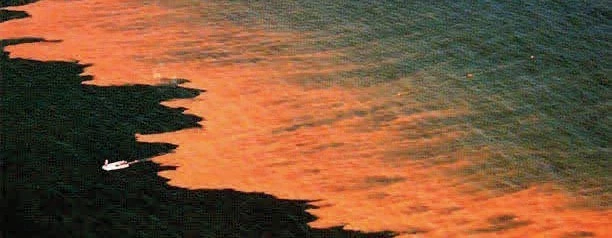Last updated: July 15, 2019
Article
One Health and Disease: Harmful Algal Blooms
Harmful Algal Blooms
Nice sunny days, warm water, and increased nutrients are the perfect recipe for algae to grow. Some algae growth is important to a healthy ecosystem. Many animals eat algae and most species of algae are not dangerous. When algae grow too much or too rapidly, it is called an algal bloom. However, some species of algae are toxic to humans, animals, and the environment. When these algae bloom, it is referred to as a harmful algal bloom (HAB). HABs occur in both fresh and coastal waters and range in colors from green, to red, to purple. Climate change and increased lawn and agricultural runoff into waters have created ideal conditions for HABs, and HABs are occurring more and more often in more places than ever before.

Photo courtesy of NOAA.
HABs and Health
HABs are dangerous to your family, your pets, and many animals. HABs have resulted in human illness and the death of pets and wildlife, including many protected manatees. Additionally, some harmful algal blooms deplete oxygen in the water, which can be distressing to many species important to the ecosystem.
During an algal bloom you may experience respiratory and eye irritation. If you experience symptoms such as coughing, sneezing, itchy throat, or watery eyes consider leaving the area for an unaffected location. If you have a pre-existing condition, such as asthma, these symptoms may be more severe.
Additionally, people and pets should not swim in waters experiencing a harmful algal bloom. Swimming can result in skin irritations and possibly make you and your pet very ill. Keep pets out of water and from eating dead fish or algae. Animals that drink contaminated water or eat algae-killed fish may become ill or even die.
Preventing HABs
Climate change has resulted in more sunny days, larger rainfall and runoff events, and warmer water, increasing the number and severity of harmful algal blooms. Also, certain nutrients found in yard fertilizers, pesticides, herbicides, and animal waste, such as nitrogen and phosphorus, help to create the perfect conditions for algae growth. These excess nutrients spread on yards can be washed into our local streams, rivers, lakes, and oceans.
To help prevent HABs lessen the amount of fertilizers, pesticides, and herbicides spread on the lawn. Planting native grasses, shrubs, and flowers will minimize the need for high nutrient chemicals that may end up in our waters. In addition, make sure to pick up and properly dispose of pet waste to help keep our water clean.

NPS Graphic.
Contact
Biological Resource Division1201 Oakridge Drive, Suite 200
Fort Collins, CO 80525
Ocean and Costal Resources Branch
1201 Oakridge Drive, Suite 250
Fort Collins, CO 80525
Related Links
Learn more about Harmful Algal Bloom-Associated Illness from the Centers for Disease Control and Prevention.
Learn more about the Oceans and Costal Program of the NPS.
Learn more about the Biological Resources Division within Natural Resource Stewardship and Science (NRSS) Directorate of NPS.
